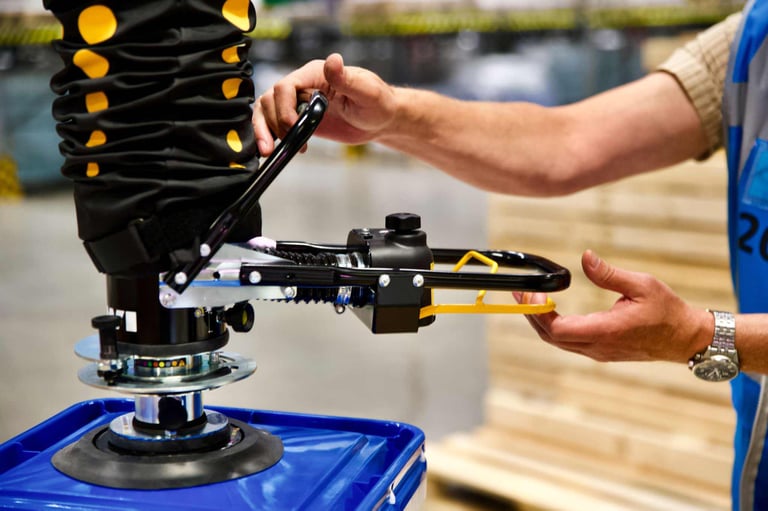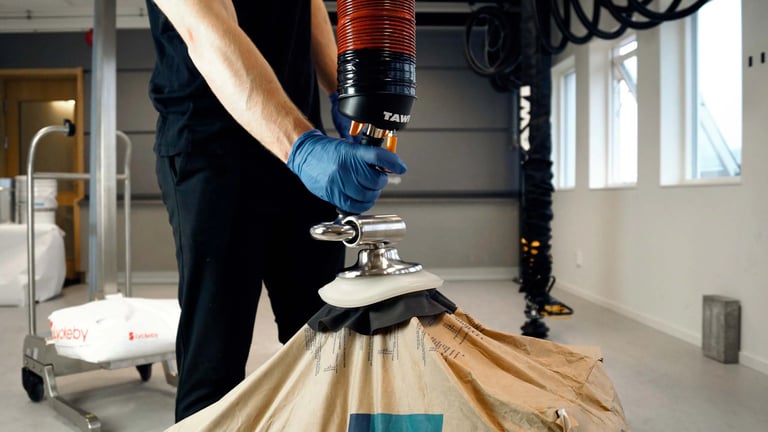What to consider when choosing lifting tools for your vacuum lifter

The vacuum lifter is an excellent lifting aid that makes material handling safe, efficient and easy. But to get maximum functionality out of your vacuum lifter, it must be equipped with the right lifting tool.
This not only enables you to lift your goods in the best possible way, but if you also have several different tools, you also make it possible to handle even more types of goods in your business. But how do you know which lifting tool is right for your goods?
There are many reasons why the vacuum lifter is such a versatile and flexible lifting aid. One of the main reasons is the ability to equip it with a wide range of suction feet, lifting yokes and other lifting tools. Changing the lifting tools is usually a simple task that mainly requires loosening a few screws. If you equip your lift with a quick-release attachment, no tools are required, and the change can be done in seconds. But how do you know which tool is best for you and the goods you want to lift?
The following steps can be used as a simple guide to help you figure out the most important things to consider when finding the right type of lifting tool for your vacuum lifter.
Step 1. What kind of vacuum lift should the lifting tool be used on?
Regardless of whether you already have a vacuum lift or are investigating whether to invest in one, it is important to know which lift you want to equip with a lifting tool. Not all tools fit all models of vacuum lifters, although it is often possible to use the same tool on several lifts using adapter plates.
Our vacuum lifts come in two distinct product groups: High-Frequency Lifters and Multifunctional Lifters. Each lift has a label on the control unit that displays the article number, serial number, and other information. If this label is missing, you can still easily identify which type of lift you have by its design since they are very different.
High-Frequency Lifters feature a single-handle grip with an integrated trigger that activates the air valve. Multifunctional Lifters, on the other hand, have two handles and a bracket that controls the air valve. Additionally, each lift has a label on the control unit that displays the article number, serial number, and other information. If this label is missing, you can still easily identify which type of lift you have by its design.

Step 2. What type of goods are you going to lift?
Different types of loads require different types of tools, so in order to choose the right lifting tool, the following characteristics of the load should be taken into account.
Surface & material
The type of surface that the load has should be carefully considered when selecting the appropriate suction feet. Depending on the surface, the suction feet should be designed to grip a smooth surface such as a pane of glass, an uneven surface such as corrugated sheet metal, or a flexible and foldable surface such as a liquid-filled sack. Additionally, the shape of the load should be taken into account; if the load has no flat surfaces, a special design of suction feet may be required in order to grip the goods securely. It is important to choose the right suction feet for the job in order to ensure the safe handling of the load.
Size & shape
No matter the size or shape of the item you are lifting, it is important to choose the proper lifting tools. There is a wide range of lift tools available, from suction cups to ox suction feet that can range from a few decimeters to several meters in length. For larger items, such as wood panels, you may need to use a larger yoke with multiple suction feet. Smaller items, such as packages for e-commerce, can be lifted using a single suction cup or a small rectangular suction foot.
Many of these lifting yokes have adjustable feet, allowing you to adjust the width between the suction feet for different-sized packages. Additionally, you will want to consider the shape of the load when choosing tools for lifting; some suction feet are only suitable for relatively flat objects, while others can easily grip curved and uneven surfaces and loads.
Weight
It is important that your load does not weigh more than what your vacuum lifter is capable of. As long as it weighs under the system's maximum weight capacity, you will be able to easily and securely lift the object. The maximum load for your lifting device can usually be read on a label on the vacuum lifter itself.
Tip!
If you need to lift several different objects with one suction foot, it might be worth looking into our quick-release attachments. These attachments make it quick and easy to switch between different suction feet, so you can ensure that the right suction foot is used for the right lifting object. For example, if you need to lift sacks and cartons, you can use an appropriate suction foot for each rather than one that is suitable for both but not necessarily optimal.
Step 3. In what kind of environment will you be using your lifting tools?
Environments without special requirements
If your work environment has no special requirements to take into account, other than the design of the facility and workstation, there is also no need to make any special customisation of the lifting tool, in addition to the things we went through in steps 1 and 2.
Explosive environment with ATEX requirements
Explosion risks exist in a variety of work environments, in everything from food and pharmaceutical manufacturing to the chemical and process industries. For these environments, it is critical that the equipment has been adapted correctly. The lifting tools for our ATEX-classified lifting systems are made of stainless steel and adapted to be grounded.
Environments with high hygiene requirements and clean rooms
In environments with high hygiene requirements, also called a clean room, often in the food industry and in pharmaceutical production, it is generally required that the lifting device and its lifting tools are stainless steel. When it comes to lifting food, such as large cheeses or blocks of meat, the suction foot strips (the rubber or cellular rubber that is in contact with the load) or the suction cups should also be replaced with food-approved variants - for example, silicone suction cups.
Finished!
We understand that no two operations are the same. Once you've gone through these steps, you should have a clearer picture of what your needs look like when it comes to lifting tools and suction feet.
We are dedicated to finding the best solutions for our customers. We can help you identify the most efficient and cost-effective way to transport, lift, and manoeuvre your goods. Our wide standard range of lifting tools covers almost any imaginable need. All are designed to make your job easier. And our sales team is available to help you find the right lifting tools for your needs. If your operations require anything more customised, our highly experienced team of engineers and technicians will help develop custom lifting tools and suction feet.